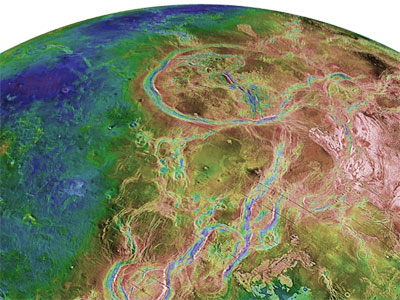The current assumptions made about Venus’ surface are wrong, according to Dr. Warren Hamilton, a distinguished senior scientist for the department of geophysics at Colorado School of Mines. He believes the surface of Venus is saturated with impact structures and its lowlands are covered with marine sediments.
Hamilton disagrees with most leading scientists today who believe that, “Venus was resurfaced by plumes about 500 million years ago, [and] there has been almost no further change under [the] hot anhydrous atmosphere, and the only preserved impact structures are sparse, small, and younger than the resurfacing.” This ideology, however, known has plumology, has many holes, which were pointed out by Hamilton in his presentation.
The idea of plumology stems from speculation made by theorists from 1982-1985, who suggested that “…Venus is too mobile internally to retain any ancient features, so [the] surface must be young and endogenic, likely produced by plumes.” These “plumes” which originate in the center of the planet are purported to be “blown thousands of km off course by ‘mantle winds,’ or… take complex routes, or… tunnel thousands of km horizontally in the upper mantle and squirt up volcanoes anywhere at any time.”
As Hamilton said, “The behavior of plumes is whatever is imagined wherever plumes are postulated.” Many leading scientists also believe that “Venusian topography was produced dynamically by up-and-down, push-and-pull plumes approximately 500 million years ago, and has ever since been precisely maintained.” Despite the questionable science behind these “plumes,” plumology remains popular, and advocates for the theory now claim that it is not possible to be tested. In essence, plumology has really become mythology.
The ideas were presented before Venus was ever seen, but nonetheless “became dogma before [the Magellan spacecraft] flew.” Therefore, when Magellan imaged Venus in late 1990, instead of trying to make determinations of what was happening from the images, many scientists made the images match the theory. The scientists believe that the entire planet was resurfaced approximately 500 million years ago, so they said that anything that is not a relatively small and new crater is instead caused by the “plumes.” The images serve as examples of this. Everything shown, which varies from items 10 km in diameter to 2000 km in diameter, is considered the product of plumes by most scientists, while Hamilton believes that they are actually impact craters.
To reinforce his claims, Hamilton references the moon. Some of the largest craters observed on the moon are well dated to have resulted from impacts around 3.9 billion years ago. He believes that Venus, which has almost twenty times the capture cross section of the moon, received scores of large impacts of about that age and size. He also believes that the reason some of the supposed impact sites are more worn down than others is because at one point they were underwater. This idea is supported by the fact that Venus’ atmosphere is 96% carbon dioxide, which can be produced by a reaction of water with solar wind.
Hamilton said, “The era of oceans and marine sedimentation clearly overlapped the post-3.9 billion year small-impacts era and some of the circa-3.9 billion years large structures, and may have overlapped the preceding impact saturation era.” He maintains that this is the reason that Venus looks as it does today, not because of a resurfacing that occurred 500 million years ago.
He asks future planetary scientists to use critical thinking when considering how Venus came to be as it is today.



'Dr. Hamilton discusses surface of Venus' has no comments
Be the first to comment this post!